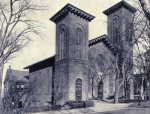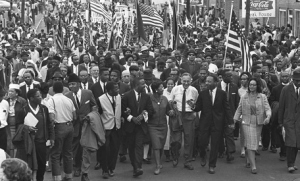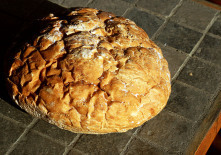Ann E. Michael's Blog, page 60
January 21, 2015
Voice
A listserv member offered this quote from Kunitz:
���One of my convictions is that at the center of every poetic imagination is a cluster of key images which go back to the poet���s childhood and which are usually associated with pivotal experiences, not necessarily traumatic. That cluster of key images is the purest concentration of the self, the individuating node. You can tell the poets who are working at their center by the distinctiveness of their voice, their constellation of key images, their instantly recognizable beat.��� … from Stanley Kunitz‘s 1975 lecture at the Library of Congress, “From Feathers to Iron.”
A constellation of key images may seem to be imagery, not voice at all; but Kunitz’s decision to connect distinctive voice with a recognizable beat and images, and to further suggest that these mesh to in the compositions of a poet who is writing with clarity and authenticity (my interpretation of what he means by “working at their center”), indicates that voice is a critical component of poetry. I have read the above-mentioned lecture, but Kunitz does not there elaborate on whether he means the writer’s personality, style, or attitude or whether he means, instead, persona. It seems to me, though, that he wasn’t talking about persona (the “speaker” or mask the writer uses in an individual piece). I interpret that the key constellation of images, the “individuating node,” would have to be personal experience of the actual writer–Roland Barthes be damned.
Gaston Bachelard’s phenomenological approach to poetics and, to some extent, psychology, appears to jive with Kunitz’s pivotal childhood images. It is easier to recognize one’s own key images in one’s work, of course…and I cannot help but recognize that Kunitz has nailed it for me, at least, if not for all poets (writers, artists, musicians, etc.). My own cluster of images, drawn from childhood, include the church. Also the beat of hymns and responsive readings and the King James and RSV Bibles. Also the bleat and wail of diesel engine horns, the progression of fields and trees and flowers, the hum of highways, the sluggish flow of certain rivers. To mention but a few that stay with me.
I am not an adherent to any particular style or form of literary critique, and I am not a whole-hearted phenomenologist, either–but I have to admit that these concepts (the individual’s key images, the individual voice and the persona voice, the rhythm or beat of a writer/speaker) intrigue me. I find them well worth exploring, mulling over.
See Dave Bonta’s Via Negativa post here for a mini-photo-essay that illustrates what I mean.

January 18, 2015
Guest blogger: memoir
Today, I introduce a guest blogger dear to my heart, my 81-year-old father, Tom Michael.

Tom Michael as a young minister in New York.
The March to Montgomery, 1965
by Tom Michael
A memorable experience I want to relate to you happened in 1965, when I was a 32-year-old co-pastor of a tall steeple church, First Westminster Presbyterian Church in Yonkers, New York. The United Presbyterian denomination was committed to the civil rights struggle, even though, as Martin Luther King said, the most segregated hour in the week was 11 o���clock on Sunday morning.
The call had come out from our denominational national committee on religion and race to ask clergy and laymen to participate in demonstrations throughout the South supporting voting rights for Black citizens. Small groups of ministers were asked to march around the courthouse in Philadelphia, Mississippi. My colleague and I flipped a coin and my colleague went down there. It was a potentially dangerous task, but he was able to return home safely.

First Westminster Presbyterian Church of Yonkers NY, 1964
After the first march from Selma was halted by police on the Pettus Bridge, they asked for volunteers to join the Freedom Marchers who had started out from Selma, Alabama on the way to the State capitol in Montgomery. It was my turn to go. So I had the rare privilege of participating in the March on Montgomery for voting rights. While I had very little influence on what happened there, it had an enormous influence on me. It was both an exciting and learning experience for me.
I first had to raise the money to go, so I asked members of the congregation to contribute to my trip. One member, a president of a savings and loan bank, disapproved and spent a long time on the telephone angrily telling Bonnie that I should not go. His wife quietly slipped me some money. That was something I learned about my congregation.
I carried along a change of underwear and some toiletries in an overnight case. That was the second thing I learned: don���t carry a suitcase on a civil rights march. This March I suspect that you will see newsreels of that event as we commemorate the fiftieth anniversary of the march. If you spot a skinny young man with big ears carrying a small suitcase, that will be me.
I don���t recall much of how I managed to get on an airplane, but soon I found myself on Delta Airlines. The stewardesses (remember when there were stewardesses in airplanes?) were lovely young women with southern accents. The pilot came on the intercom to tell us about the flight. He also had a southern accent. I thought, ���Thank heavens, the pilot is in the plane.���
When we reached Montgomery we were taken to the campus of a school for colored girls on the East side of the city. There were, I���m told, twenty-five thousand of us milling about. Darkness came. There were two points of light: one, to my right, was a communications stand manned by Gary Collins, a movie actor who at that time was married to Lucille Ball. The other, directly in front, was a stage. We were entertained through the night by an all-star cast: Harry Belafonte, Tony Bennett, Frankie Laine (he sang ���Mule Train,��� “clippety clopping through the wind and rain,���), Sammy Davis, Jr., Joan Baez, Nina Simone; and we sang, with Peter, Paul, and Mary, ���We shall overcome, we shall overcome, we shall overcome some day.���
Late at night we were assigned places to sleep. Mine was in the balcony of a one-room Baptist Church. At the other end of the pew was a man who snored all night long. In the morning I sat up and waited my turn to use the single bathroom. As I waited, I watched in fascination from my balcony perch as a coed with a Purdue University sweatshirt combed her blond hair into a beehive hairdo. That was the third thing I learned, though I don���t believe it has done me much good.
After breakfast we waited around the grounds for the march to begin. I happened to meet up with Dr. Gayraud Wilmore, whom I had met when he attended a Presbytery meeting to inform us of his work as executive secretary of the United Presbyterian Commission on Religion and Race. He was accompanied by the Rev. Metz Rollins, who was a field director for the United Presbyterian Board of Christian Education. As we were chatting, a white southerner walked up and was greeted by these two. They introduced me to him. His name was Myles Horton, founder of the Highlander Folk School in Tennessee. This school was responsible for training Rosa Parks, James Abernathy, John Lewis, Martin Luther King, Jr. and many others in the skills and tactics of non-violent resistance. While we were talking, a man joined us, and he was introduced to me as Charles Evers, brother of the slain civil rights worker Medgar Evers. As I shook his hand I said, ���It is an honor to meet you.��� He acted as if he didn���t believe he deserved that, and I learned later that he had spent time in Chicago engaging in criminal activities. Then a Union Theological Seminary classmate of mine, who was there from his home in Minneapolis, came by.

AP photo 1965
At long last the march began. We walked into the city on a main street that was lined with houses. Many of the locals were sitting on their front porches looking rather grim as thousands of us so-called outside agitators filed past. I caught the eye of one woman on her front porch and motioned to her to join us. I received a most hateful response.
My seminary classmate had offered to write dispatches for his local newspaper, so as we marched along we caught up with a slightly built older man. My friend decided to interview him. When he asked his name, he replied ���Willard Uphaus.��� Uphaus, a Methodist lay preacher, led a social action group with summer headquarters at Conway, NH. The New Hampshire Attorney General, empowered by the State Legislature to investigate subversive communists, demanded that he turn over the names of guests at the World Fellowship of Faiths. Dr. Uphaus freely testified about his own activities but refused to provide the names of others. In 1956, he was found in contempt by the Superior Court in Concord, NH. After the conviction was upheld by the United States Supreme Court in a 5-to-4 vote in 1959, Dr. Uphaus spent nearly a year in jail.
I began to think I was in Bunyan���s ���Pilgrim���s Progress,��� meeting up with stalwarts of the faith as we made our progress toward the Alabama State House. When we arrived there I took up a position in the center of the street in front of the statehouse. At the far end on the right side was an American flag. On the left side near us was the Confederate flag. I found myself resenting that flag. It was a slap in the face of all the descendents of slaves who had been oppressed and humiliated.
It was a hot day. I sat on my little suitcase. I had a headache. I thought ���I am here. I am nowhere else.��� There were several speeches, of course.
Then Martin Luther King gave the final speech, ending with the stirring words, ���When will the radiant star of hope be plunged against the nocturnal bosom of this lonely night, plucked from weary souls with chains of fear and the manacles of death? How long will justice be crucified, and truth bear it?…I come to say to you this afternoon, however difficult the moment, however frustrating the hour, it will not be long, because ‘truth crushed to earth will rise again.’ How long? Not long, because no lie can live forever. How long? Not long, because ���you shall reap what you sow.��� How long? Not long, because the arc of the moral universe is long, but it bends toward justice.”
Then we began the trek to return to our homes. We were told to go to what they called the colored section of the city, to the right of the statehouse. I was struck by the irony that I, a white man, should feel a sense of relief when I crossed into the ghetto. I found Gay Wilmore. He had rented a full sized Buick sedan and was planning to drive to the Atlanta airport with Metz Rollins. I figured that the airport in Montgomery would be chaotic, so I asked to ride with him. My seminary classmate joined us, and a young man from the Student Non Violent Coordinating Committee. He looked fierce with a black beard and dreadlocks, but he was in fact a most gentle young man.
So there we were, three Black men and two white men. We struck out on Interstate 85 toward Atlanta. After a while we needed to get gas and make a pit stop. Gay and Metz peered intently at each service station, asking, ���Is that one?��� This was another thing I learned. It is one thing to hear about segregated facilities in the South, and it was another to actually experience it. Here were two prominent, highly educated clergy reduced to the humiliation of having to bypass facilities that would refuse to serve them because of their race.
Finally, we found a station that would serve us. For my part, I was not able to tell the difference, but they had lived a lifetime of picking up the subtle clues about where they could be served. After we had finished, Gay Wilmore announced that he was sleepy, and would someone else drive. I was the only one who had my driver���s license, so I took the wheel. At that time the speed limit on highways was 55 miles an hour, and I was observing the speed limit. As I drove along, a string of cars passed us by traveling faster. Then an unmarked state trooper whizzed past and pulled over eight or ten speeders. I drove carefully on the outside lane at 55.
Gay Wilmore said to me, ���OK, Tom, if a trooper pulls you over for speeding, just tell him ���I���m just trying to get these (he used the N word) out of here as fast as I can.������ I guess it was a form of gallows humor. After we left the interstate we traveled in the darkness through small towns in Georgia.*
I carefully observed every speed limit sign, I came to full stops at stop signs, and if a traffic light even hinted that it was turning red, I stopped. Since that time I have observed speed limits and stop signs. You will never catch me traveling more than the speed limit anywhere.
At long last, late in the night, we saw the towers of Atlanta glowing in the distance. It reminded me of the experience when Dorothy and her friends first caught sight of the Emerald City of Oz.
At the airport we took our leave of one another as we boarded our airplanes. Gay Wilmore saluted me in the manner of a French general, kissing me on both cheeks. I boarded the plane and sat next to a man who looked very familiar. I believe he was Ralph Bunche, Nobel Peace Prize winner when he was assistant secretary general of the U.N. I did not ask him who he was, since I believe that famous people should be allowed some privacy; and besides, he immediately fell asleep.
When we arrived in New York I shared a taxicab with an editor of Time Magazine. The taxi driver, an African American, asked us where we had come from, and when we told him that we had been on the March on Montgomery, he said he had been watching it on TV. My companion gave the cabby an address on the upper West Side of Manhattan. I said that I wanted to go to Grand Central Station so I could wait there a couple of hours until a train could take me to Yonkers. The cabby said, ���I could take you there.��� ���But,��� I said, ���I only have five dollars on me,��� and I knew that the fare from midtown to Yonkers was at least three or four times that amount.
���Well,��� he said, ���You did something for me today, so I will do something for you.��� And with that he took me all the way to my front door.
=
*Civil rights activist Viola Liuzzo was murdered by Klansmen the same day, also while driving African American protesters to the airport and bus stations.
~
For another story of the march and some pictures, see this lovely interview with photographer James Barker (on the Smithsonian’s website).

January 14, 2015
Protest (Selma)
The past 10 months have been especially notable for public protest here and abroad. As it happens, I’ve been trying to write a poem about my father’s participation in the voting-rights march (1965, Selma to Montgomery AL), a kind of occasional poem to commemorate the 50-year anniversary. Then the movie “Selma” was released, which I just saw at the cinema.
The film, like all “based on a true story” dramatizations, may have focused on perspectives of the protest that worked best for the scriptwriter, may have some historical inaccuracies, may raise some controversy. But as a child whose parents were, though marginally, connected with civil rights through the churches’ participation, the movie felt true in the big way: “capital T” True. Funny, the aspects of the film that engaged me: how I could immediately identify who the actors were portraying (Abernathy, Young, Lewis); the way so many important discussions took place in church basements and classrooms (as the child of a minister, I am intimately familiar with church basements and classrooms); the televising of Bloody Sunday.
And another True thing:�� the familiar, biblical-style, preacher-cadence and allusions in King’s speech. People do not talk that way anymore. But they once did, and I recall it well. Rhythm and intonation and the use of allusions and analogies impress the sort of listeners who eventually become poets, I am sure of it.
Right now, I am struggling with my poem. I am not sure I will ever complete a draft that I feel pleased with–maybe it will end�� up in my “dead poems” file. What I will do instead is to devote my next post to my father’s depiction of the Selma-to-Montgomery march, from his point of view, looking back 50 years.


January 11, 2015
Poetry, history, connectivity
We are connected, perhaps too closely, too immediately. With Nigeria and Boko Haram. With Paris and Charlie Hebdo. Ferguson, MO. Eric Garner in New York. George Zimmerman. Iraq. Syria. It’s easy to continue this list–too easy.
What we tend to want are simple solutions, dichotomies, dualities, one choice or another–not complexities and subtleties. But the human brain, the human culture, the human genome, the human body and the systems in and through which we operate are damned complicated.
~
Former US Poet Laureate Billy Collins gets a great deal of press, and sometimes he gets criticism for his popularity; but in a recent interview he states in apparently simple terms how complex the human condition is, and why we need compassion, and poetry:
The poem shows us that these emotions, love and grief, have been going on through the centuries; and that the emotion we���re feeling today is not just our emotion, it���s the human emotion.
Poetry is the only history we have of human emotions. Most history books, what we call history books, are stories of battles and treaties, negotiations and beheadings and coronations. But poetry is the only reminder of this very essential part of being human, which is one���s emotional life and all the dimensions it entails.
The history books will leave out many of the crimes, massacres, terrorist acts, and bloody little belligerent actions of people and their governments and cultures and belief systems. History cannot help but be compromised by point of view–it is always, as Churchill noted, “written by the victors,” even when they are trying to be even-handed and objective. But poetry is all about point of view. The “tell it slant” of Dickinson, ambiguity and mixed feelings, individual imaginations and individual interpretations. As Collins puts it:
I think writing and creating are expressions of an epistemological position ��� that is, how you look at the world, that slant you look at it from. And that���s all I feel I am in a palpable way responsible to: using that slant to get at some truth or a little smidgen of beauty.
It���s a matter of being true to your imagination, and being true to your vision, and true to the material you���re working with, whether it���s a violin or the dictionary of the English language. You have to listen to all the other violinists who��have ever played, and read all of the poetry you can consume. That���s my sense of responsibility. It���s an artistic responsibility, not so much a political one, not so much a financial one or a responsibility based on commodity. It can���t be commodified.
As a teacher myself, I love the anecdote in this interview about a past student who, years later, could recall a poem he’d memorized for Collins’ class. Collins says:
[T]eaching is a very mysterious process. You���re throwing information, in a sense, into the dark. I mean, you spend an hour talking to this group of increasingly younger people and you walk out of there and you think sometimes you���ve had a good class, and other times it���s not been that great. But no matter what it is to you, you���re not sure how it���s being taken or what effect you���ve had.
The story reminds me of one time when I was getting my teeth examined; my dentist (knowing I teach poetry) said to me, “You know, in college and dental school, I took Chemistry. I had five classes in Chemistry. And I never, hardly ever, in my current job, use that information. I almost never think about chemistry. But I took a class on Milton’s Paradise Lost. A poetry class, really. And�� you know, to this day–sometimes I find myself thinking about that poem. And that class, and those lines. Really. It’s stayed with me much longer, and more significantly, than any of the chemistry courses I took.”
Billy Collins would surely smile and nod if I were to tell him this story. Those connections are the invaluable sort: beyond information and into the mystery of what makes us human beings. Teachers learn from this sort of experience. It stays with us.
~
We may not be able to resolve the wars, prejudices, pride and anger and sense of�� injustice that cause people to murder one another for revenge, honor, religious feeling, economic or territorial needs, or fears so deep we may not even be able to name them. Even tolerance has its downside: a tendency to refrain or excuse when speaking up might be necessary, if dangerous. Not all of us enjoy the learning we can gain from adversity or from trying to understand our enemies, who may not respect a willingness to listen. Not all of us learn from great literature, or have the patience to live with art that discomfits or challenges us. It is easier to paint Satan with the broad brush of evil, when Milton’s character possesses nuance and depth. The same with Mohammed or Jesus, the Pope or Buddha, Putin, Obama, or any world leader or financial oligarch.
We are all people in the world, flesh and bone, loved by someone, suffering and gratified by daily life, under the same sun and moon. The sun and moon that have appeared in poems from time immemorial. The biosphere that connects us whether we like it or not.

January 8, 2015
Gestation
Without committing to any resolution to do so, I spent some time recently with my own poetry: the unfinished drafts, the partially-revised pieces, the fragments and the poems I had put aside for the time being. “For the time being” was, in some cases, over a decade.
This putting-aside led me to wonder what process–other than forgetfulness–leads me to abandon a poem for such a long time. I am aware that artists in other media experience this sort of pause in the working of making; sometimes, the years on a project are full of revision and detailing (Rodin’s doors “The Gates of Hell,” for example) but often, the composition just lies about for a perhaps-indefinite number of years. I believe the poet Donald Hall refers to this as a poem’s necessary gestation.
In a 2008 interview (by Wendy Andrews), Galway Kinnell said, ���When I can take a poem of mine that I think is finished and put it aside for a month and pick it up and read it and find it interesting, and if I encounter no place where I think it should be changed, and if at the end it surprises me, even though I wrote it, I think it might be done.���
That’s what I have been endeavoring to accomplish for the past two weeks or so: a reading of my own drafts to discover whether any of the poems are capable of surprising me, or if any of them might be revised into achieving that state. It is a lengthy project and a quiet one that requires considerable internal analysis and an objective stance. And maybe that is one benefit to letting the work sit around for so long…by the time I peruse the draft again, I have forgotten the initial inspiration, so the poem has to operate on its own merits as a composition rather than through any residual inclination or emotional attachment I may have once had for it.
If my own work manages nevertheless to impress me in some way, I tend to harbor the hope that it may be salvageable.
The parallels to pregnancy and gestation may be inevitable–parents harbor hopes that their children will be good people who are successful in the world, just as poets want their poems to be “good” –but that sort of gestation analogy only goes so far. We cannot revise or rework our human offspring, and an objective analysis of their strengths and weaknesses is unlikely to lead to betterment of either party. But a work of the imagination can be re-envisioned, reconsidered, and made new.
That’s the work of the next many weeks. I am curious indeed as to where the work, after its long gestation, will lead me.

December 31, 2014
Spaces
Ah, the traditional New Year’s blog post! :) I have spent time away from the computer to tend to other things, among them, my own “space” for being less busy. Finding that space has not been easy, but it is the sort of discipline we human beings ought to practice in this Age of Information. Without a little inner space, it is far too easy to become anxious and overwhelmed.
So I think of Bachelard’s quiet exhortation to cultivate the creative or childhood space, which I contemplated in 2013 at about this time of year (in this post). And I think of Jon Kabat-Zinn and other writers–often classed as spiritual self-help authors but whose writings need not be considered spiritual at all (Kabat-Zinn, in particular, avoids using the term)–who remind us to be attentive, aware, mindful, compassionate even to ourselves, and willing to take ourselves away to inner stillness now and again.
I am particularly drawn to the notion that contemporary human beings can come to mindfulness through actions rather than through withdrawal from the body and the world. Really, we hardly have any other choice. Although I enjoy solitude more than most people do, I am ill-constituted to be a hermit or a renunciate. My temperament precludes noisy advocacy against injustice or for specific good causes; but I could certainly do more helping, more of the kind gesture, more listening, and more giving of the type that lets not my left hand know what my right hand doeth (Matt. 6:3).
There were difficulties this past year, and aggravations, and sufferings both personal and social. So be it; we can learn from failure and adversity. The best way to learn to problem-solve is by being faced with problems!
In his 2000 book about aging and dying, Ram Dass wrote: “My guru once said to a visitor complaining about her suffering, ‘I love suffering. It brings me so close to God.’��� Well, that is another way of looking at things; and perspective matters. Creative thinking involves full analysis (even when the analysis seems intuitive, immediate) and often employs a total restructuring of the problem at hand–a widening or narrowing of scope, a different point of view, a new set of tools or skills for puzzle-solving, or quiet cogitation while the thinker digests the whole situation…which may be, for some folks, prayer.
Or poetry. When I am not writing poetry, I am always reading it. Other writers’ words open me to a sense of communal understanding, a sense that we are not alone, not a single one of us, who can hear or read or remember a poem or a word of love or praise. Even when those poems depict sorrow or suffering, for then we know we are not the only ones who feel troubled.
���And our problems will crumble apart, the soul
blow through like a wind, and here where we live
will all be clean again, with fresh bread on the table.���
Let the wind make space for fresh bread on your table in 2015 and always.

bread

December 20, 2014
Winterberries & solstice-tide
December 12, 2014
The empathy button
Human nature being what it is, and our feelings being so rooted in often physiologically-based emotions, negative responses tend to aggregate. The book I just finished reading–Damasio’s The Feeling of What Happens–offers neurological, evolutionary, and psychological reasons for the human tendency toward negativity. Dozens of psychological studies concur that humans in general feel more “bad” feelings, and more frequently, than “good” feelings.

Facebook has a “like button,” as do many blog hosting pages (see below for mine!). This ingenious algorithmically-programmed information-gathering software–I hesitate to call it a device, but I guess it is–offers social media users a shortcut to social interaction, a way to show conformity and agreeability among friends, to support a statement or cause, or to indicate pleasure at seeing a photo, work of art, or shared piece of information.
Other sites, such as YouTube, have the additional option to “dislike;” and though I have not read any research supporting this inference, I would speculate that the option to dislike could lead to the generation of more negative feelings. Human nature being what it is.
If social media users cannot take the time to type their feeling-based responses and just need something to click, why not offer a “compassion button?”
I am not serious, of course. The compassion button is internal, and it isn’t an immediate gut reaction for most of us. It moves us from emotions such as anger or ideas like reason and duty to shared human experience. It takes us from simplistic liking or disliking to understanding. It takes more than a mouse click to get to compassion.
���Love and compassion are necessities, not luxuries. Without them, humanity cannot survive.���
��� Dalai Lama XIV, The Art of Happiness

December 7, 2014
Continuing the discussion
The semester is almost over, and my students and I have spent a few weeks doing writing that relates to Cass Sunstein’s book Why Societies Need Dissent. As it turns out, this semester coincides with considerable current-event attention on protest, conformity, stereotyping, and other issues Sunstein explores in that text. Social media pushes the herd mentality, the “troll” mentality, and the ease of using shortcuts in thinking: justification through bad analogies, irrational responses, barely-considered ideas, culturally-entrenched concepts, knee-jerk reactions.
In other words, the gamut of human social psychology in 140 characters or thereabouts, with links, memes, and dudgeon.
A case in point that appeared on social media last week is a photo of a black man holding a sign that reads, “No mother should have to fear for her son’s life every time he robs a store.”
That was a photoshopped “joke” in which someone altered the last line of the protester’s poster. The intent was to assert that Michael Brown had robbed a store before walking down the middle of a Ferguson street, and the intent was clearly meant to suggest that Brown deserved to be shot by police–or, at any rate, to suggest that he was not “innocent.” I agree with the poster even in its altered state because I propose that none of us are innocent, and that none of us deserves to be killed. A suspected robber should be tried by jury and should be considered innocent until proven guilty because that is the way US law reads.
I do not claim that “It’s that simple.” Indeed, the situation is far from simple, which is why it feels so fraught and inflames such exertions of logic, law, and character defamation, and so many conflicting opinions–not to mention Facebook “purges” and irate newspaper columns and public protests. These are reasons that discussion can be useful. We need to continue the discussion, even though it is awfully difficult to do so.
~
If only we could listen to other perspectives. If only we could engage in discussion. I listened to two of my male students talking about being stereotyped. One claimed he was seldom troubled by harassment and not really bothered when people tried to stereotype him. “You’re not black,” his friend responded, “You’re Latino, or whatever.” The first man held up his arm: “Hey, man, I’m darker than you. What makes you black and me not?”
“Neighborhood. Money.”
“Look at you, bro! You’re wearing $185 shoes and new jeans. Dollars to donuts your family has more money than mine.”
They continued in this fashion awhile, sometimes asking me what I thought. If it was history that made them different, couldn’t the black man put it behind him? And he didn’t even really know much about “his” history, it turns out. If it wasn’t skin color that made one man feel less sure of himself on the street, warier, even in a “good” neighborhood, to what could it be ascribed? Was it just a personal issue? A neurosis? Was the Latino man clueless, or oblivious? Or just lucky up to now? Are these issues of confidence, self-esteem, bravado, or fear? Social issues or private ones? All of the foregoing?
And how does all of this relate to how young people of any background, religion, or color comport themselves in the world, deal with society and its assumptions, codes, expectations?
~
I teach writing. My job consists in instructing students in the perhaps arcane code that clear, concise, informational, and persuasive writing requires if they are to succeed in writing for academia and, later, the world of business information. I tell them: “This is what you should expect others/authorities to expect of you. It’s your choice to follow the conventions or not to follow the conventions, but you need to at least know what the conventions are.”
Meanwhile, I hope they recognize that they should follow the conventions of the rule of law; and if they choose to oppose the law, they should do so with forethought and initially, at least, within the structure of the law. But bad laws do need to be changed, and bad protocols need to be changed, and unarmed people should not be killed for brooking authority; and stereotyping–a very natural and automatic human behavior though it is–should be consciously questioned, even though yes, that can make the discussion difficult.

December 3, 2014
Some endings
On a bleak wet day: thinking about revising my poems. The pile of “needs work” drafts appears daunting; I have put off for too long the required work of rethinking, the hard, conscientious effort–and unstructured time–necessary to the craft. I have always enjoyed the task of revision because it offers a chance to revisit the initial urges of the poem and to refine and reconsider my ideas, but lately my motivation has abandoned me.
I notice, above, all of the words that begin with “re.”
Latin: “in the matter of” or, (res), “thing.” But as a prefix: “again,” likewise, to indicate a backwards or repetitive motion.
revise���� �� ���� require���������� �� �������� revisit�������� �� ���� refine���� ��
������ rethink������ �� ������ reconsider
Maybe I am eager to move forward instead of always going back. Nevertheless, one method of moving on is to complete what one is working on so as to create a sense of closure. Sometimes, all a poem needs is a better ending.
When I think of revision under that perspective, as a means of completing an unfinished job in order to prepare for the next, new task, the pile seems slightly less unmanageable.
And by way of re-envisioning the endings…Molly Spencer’s blog The Stanza offers a good list of closure options here.
 ~The ending of a day~
~The ending of a day~








